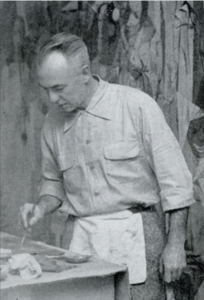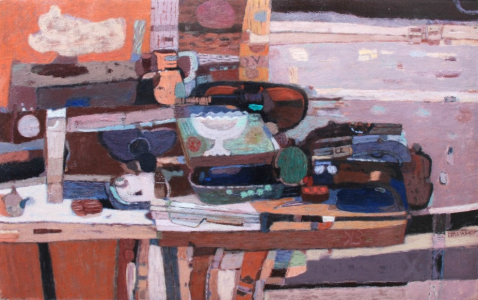
Biography
Richard Haines was a prolific and successul artist of the Depression Era and post-war periods. His art transitioned from the classic style of the American Scene of the Depression Era murals to an abstract style that defined an aesthetic known as California Modern in the 1950s and beyond. Haines's comfort with art of the American Scene goes back to his childhood, where he was raised in an Iowa farm family, sketching landscapes and cows for amusement. He got his first job as a greeting card designer and was also employed designing calendars.
Winning a scholarship to the Minneapolis School of Art, he developed an interest in mural painting, and joined the faculty of the School of Art upon graduation. He refused a scholarship offer from Grant Wood, fearing that he was already too influenced by Wood's style. In 1933, Haines received a Vanderlip Traveling Scholarship to the Ecole des Beaux Art in Fountainbleau, France, where he studied composition and fresco technique.
This training - and Haines's obvious talent - put him in good stead, and he received nine mural commissions during the next decade. These included a Courthouse in Wichita, KS; Post Offices in Iowa, Minnesota, Missouri and Washington; high schools in Denver, Minneapolis and Sebeka, MN; and a room in the Round Tower of Fort Snelling, MN. Although the Fort Snelling mural was destroyed in an effort to return the Round Tower to its original historical state, Haines's Post Office murals still exist. His high school murals are currently threatened - a shame since they are the largest compositions of his pre-war production.
In 1941 Haines and his wife moved to Los Angeles, where he worked in dye and pattern design for Douglas aircraft. Following this he effectively began a new career, transitioning from American Scene to modern art, teaching at the Chouinard Art Institute and helping found the California Modernist style of painting. He stayed at Chouinard from 1945-1954 while maintaining a studio in Santa Monica, receiving commissions for murals at UCLA and the Montebello Public Library. The high point of his output during this period was a set of murals for the Mayo Clinic, which were covered over (but not destroyed) during remodelling in 2008.
From 1954-1974 Haines was the head of the painting department at the Otis Art Institute. He served as a combat artist in Vietnam in 1967. He was successful as both a painter and watercolorist. Ironically, while his work in the midwest was being forgotten, he achieved considerable fame on the West Coast. He continued to be a productive artist up until his death in 1984.


Critical Analysis
Haines was the prototypical artist of the American Scene. He was perhaps so comfortable in this role because of his idyllic childhood on an Iowa farm. But he was not blind to trends in the art world and was eager to move on to a more abstract style. Some of his paintings in the late 1930s show the beginnings of this transition, with works characterized as much by geometric forms as by landscape or figurative elements. Videos produced by the Sullivan Voss Gallery provide a good idea of the broad scope of Haines's art and its relation to the cultural mileau of mid-century Los Angeles. His mature work was both aesthetically appealing and popular.
Murals
- Berwyn, Illinois - Post Office: The Picnic
- Cresco, Iowa - Post Office: Iowa Farming
- Wichita, Kansas - Courthouse: Kansas Farming
- Hastings, Minnesota - Post Office: Arrival of Fall Catalogue
- Sebeka, Minnesota - Sebeka High School: History of Minnesota
- Clinton, Missouri - Post Office: Coon Hunt
- Shelton, Washington - Post Office: Skid Row
References
- Staff Report, Art exhibit features historic murals, Marion Times March 20th (2013).
- Richard Haines (Gallery 5004).
- Richard Haines (askART).
- Richard Haines (LACMA).
- Richard Haines - Midcentury Master. Nathan Vonk discusses Richard Haines for SGTV.
- Richard Haines (1906-1984) (Sullivan Goss, An American Gallery). Very detailed article by Frank Goss. Sullivan Goss is representing the Richard Haines estate.
- Charles Donelan, Richard Haines at Sullivan Goss, Santa Barbara Independent April 9 (2014).
- admin, Richard Haines, Ravenna Mosaic Company, and Another Downtown Los Angeles Mosaic, Adam Arenson February 19 (2017).
- Richard Haines: Endurance. Jeremy Tessmer discusses Haines's lithographs on SGTV.
- Subdividing the Space. Jeremy Tessmer discusses Haines on SGTV.